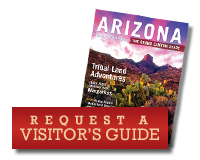In Arizona, wildlife happens. Often. From mountain parks to national parks; isolated wilderness areas to accessible wildlife areas; and around rivers, creeks and ponds. Birds, mammals and big game appear, sometimes in the strangest places (such as backyards).
Often, you just have to know where to look – and when – to get a glimpse of Arizona’s animal diversity. From north to south, take a week to wind through the state, seeking out wildlife encounters all the way.
Stop 1: Skirt the canyon in Northern Arizona
Take a road trip on the scenic Kaibab Plateau-North Rim Parkway to the north rim of the Grand Canyon. Along the way, you’ll pass rolling hills, huge meadows and aspen-fir forests that make perfect habitats for a wide range of wildlife.
During early morning or evening hours, watch for deer browsing in vast meadows. In autumn, you might catch a flock of Merriam’s turkeys edging an aspen forest glowing gold from autumn color.
Inside the forest, Williamson’s sapsuckers beam yellow bellies and tassel-eared Kaibab squirrels romp. Resident California condors glide in the afternoon thermals near the canyon’s rim. But plan ahead, the road closes on the first snow after October 15. (The canyon’s South Rim stays open year-round.)
Tip: The Grand Canyon is a raptor flyway during September and October. Keep your eyes on the skies for around 17 different species of migrating raptors, from merlins to bald eagles.
Stop 2: Winged wonders in Arizona’s West Coast
Starting at the northern tip of the Topock Marsh, heading south through the dramatic Topock Gorge, then down along the rugged ridgelines of the Havasu Wilderness, the Havasu National Wildlife Refuge has some of the best birdwatching on the Lower Colorado River.
About 300 species of birds appear each year in the refuge, including migrant Canadian geese. When dawn breaks over the desert mountains along the river, watch the ridgelines for bighorn sheep.
Tip: Have a high-clearance vehicle or like to hike? Check out the canyon roads in Kofa National Wildlife Refuge, where one of the nation’s largest herds of desert bighorns roam.
Stop 3: Urban habitats in Phoenix & Central Arizona
You don’t have to leave the city to spot wildlife. When in Phoenix, do as the Phoenicians do – take a hike in the Phoenix Mountains Preserve for chance encounters with ringtails, coyotes, cactus wrens and quail. White-throated swifts dive from cliffs, and roadrunners zoom around on the ground.
The 3.7-mile-long Freedom Trail always has surprise sightings – and you may get an earful from a chatty coyote on the easier 2.5-mile-long L. V. Yates Trail on Piestewa Peak.
Birders will find a flurry of avian activity along the banks of the Salt River at the Rio Salado Habitat Restoration Area. The former-dumpsite-turned-urban-oasis draws more than 200 bird species to its wetlands and riparian habitat. Explore the restored riversides on 16 miles of trails on your own or as part of a ranger-led hike, bike ride or bird walk from the on-site Nina Mason Pulliam Rio Salado Audubon Center.
Tip: Snakes coincide pretty uneventfully with humanity. Nevertheless, keep dogs on a six-foot leash and tread carefully.
Stop 4: Big game in North Central Arizona
Take a drive on the Coronado Trail Scenic Byway and get ready to glimpse big game wildlife, from bighorn sheep just north of Clifton to pronghorn antelope on the 4 Bar mesa grasslands, to turkey, elk, and deer, plus bears or even a mountain lion or a Mexican grey wolf north of Strayhorse to Alpine.
For an up-close and personal experience with wildlife, hike the Bear Wallow Trail, which lives up to its name, in the Bear Wallow Wilderness just south of Hannagan Meadow. The forest is an elk migration path and draws all kinds of big game.
Tip: Explore the back roads that branch off the highway for slower sojourns through meadows and forests, especially in late afternoon to evening, when animals are more active.
Stop 5: All aflutter in Tucson & Southern Arizona
When their homes in the northern reaches of the continent start to turn frigid, tens of thousands of sandhill cranes begin to arrive at their winter residences at the Willcox Playa and Whitewater Draw wildlife areas in the Sulpher Springs Valley.
The elegant bird with a folklore that portends long life and prosperity mingles in these wetlands along with Canadian and snow geese at night and raids area cornfields by day. Each January, the area hosts the Wings over Willcox festival to celebrate and study these and other birds.
Tip: The valley attracts about 12 different species of raptors and is one of the best, nationally, to spot wintering sparrows (about 20 different species).



